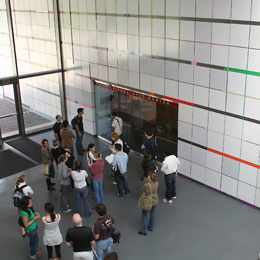List Visual Arts Center facts for kids
The List Visual Arts Center (LVAC) is a special art museum at the Massachusetts Institute of Technology (MIT). It started in 1950. The LVAC is famous for showing new art in its galleries. These galleries are inside the MIT Media Lab building. The center also takes care of a huge art collection. This art is placed all over the MIT campus, in offices, and even in student homes.
Contents
History of the LVAC
The first art space at MIT opened in 1950. It was called the MIT Hayden Gallery. This gallery was next to the Hayden Library. Today, that space is a performance hall called Elizabeth Parks Killian Hall. It is used for music, talks, and theater.
In the early 1950s, the Hayden Gallery showed art by Alexander Calder. He made cool moving sculptures called mobiles. By 1970, the gallery was showing many modern art exhibits each year. One famous show was Exploration. It was put together by the MIT Center for Advanced Visual Studies. This show had interactive art. It featured light-based artworks by Wen-Ying Tsai, William H Wainwright, György Kepes, and Takis.
In 1985, the museum moved to a bigger space. It is now in the Wiesner Building (E15). This building also houses the MIT Media Lab. The famous architect I. M. Pei designed it. The museum was renamed the List Visual Arts Center. This was to thank Vera and Albert List for their generous gift.
What the LVAC Does
The LVAC is known around the world. Each year, it puts on 6 to 9 new art shows. These shows are in its galleries, which are about 6,000 square feet. Everyone can visit these galleries for free. Most events at the LVAC are also free. This includes fun, hands-on art workshops for families.
The LVAC is located in the Wiesner Building. This building was designed by I.M. Pei. It is easy for everyone to access. The building itself has art built into it. This includes works by painter Kenneth Noland and sculptors Scott Burton and Richard Fleischner. These artworks were created through MIT's Percent-for-Art program.
The Percent-for-Art program is managed by the LVAC. It sets aside money for new artworks. These artworks are created whenever MIT builds a new building or makes a big renovation. Past art pieces include Transparent Horizon by Louise Nevelson. It is in front of the Landau Building. Another is a colorful floor by Sol LeWitt in the Green Center for Physics. Also, Anish Kapoor's Non-Object (Plane) is in the Stata Center.
MIT's Permanent Art Collection
The LVAC also takes care of a permanent art collection. This collection has over 3,000 pieces of modern art. You can find prints, photos, drawings, paintings, sculptures, and more. Most of this art is placed around the MIT campus.
The public sculpture collection has over 50 major artworks. These are by famous artists like Alexander Calder, Jorge Pardo, Henry Moore, Pablo Picasso, Louise Nevelson, Sarah Sze, Dan Graham, Jean-Robert Ipoustéguy, Cai Guo-Qiang, Jaume Plensa, Frank Stella, and Mark DiSuvero. This public art collection has been called "one of the best of its kind."
You can find an online map of all the public art. There are also audio guides you can listen to. These guides tell you about certain artworks. You can also find information about the main MIT buildings.
The LVAC also runs the Student Lending Art Program. This program has over 700 original artworks. These are mostly framed pictures. Through this popular program, students can borrow art for their dorm rooms. Since 1977, all the art available for loan is shown in a big exhibit in September. Anyone can come see this show. Each year, about 15 new artworks are added to the collection. Some older, very valuable pieces are moved to the permanent collection. New art is chosen with advice from the MIT Council for the Arts. They usually pick limited edition prints or photographs.
There is also a Campus Loan Art Program. This program loans art from the permanent collection. This art is displayed in offices for staff and professors.
Awards and Recognition
The LVAC has been chosen three times to help represent the United States at the Venice Biennale. The Venice Biennale is a very important international art exhibition.
- In 1999, with artist Ann Hamilton.
- In 2003, with artist Fred Wilson.
- In 2015, with artist Joan Jonas.


